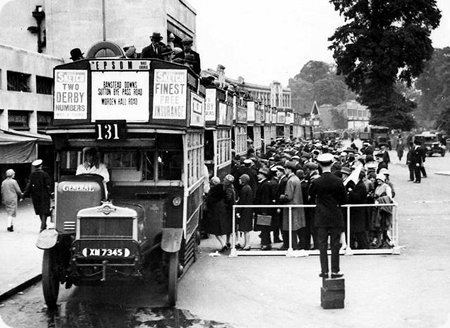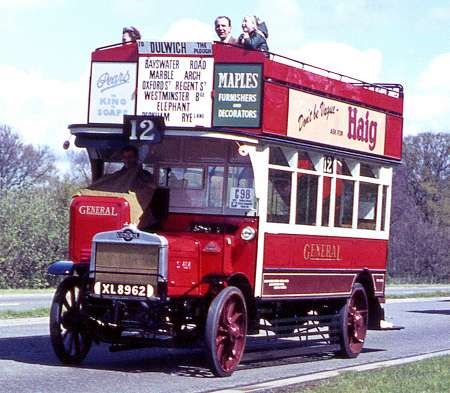London General – AEC S-Type – XM 7345

Photograph by ‘unknown’ if you took this photo please go to the copyright page.
London General
c1920
AEC S-Type
LGOC O30/26RO
Here is a wonderfully evocative photo of Morden UndergrounD Station (near to where I grew up) with the Derby Week ‘racing fraternity’ in full flood, having arrived by Tube and queuing up for transporting to Epsom Downs/Tattenham Corner. I count about twelve of these bone-shakers. At the end of the day, the scene would be played out in reverse! Note the inspector on his boxes directing what appears to be a very smooth operation. One wonders if he was a tic-tac man in his off-duty hours!
The S-Type bus was first introduced around 1920. It was larger than the similar-designed K-Type, and could carry 56 passengers as opposed to the slightly earlier and smaller K-Type’s 46, making it popular on the busier routes. They were withdrawn between about 1930 and 1932, as new and infinitely better LT and ST types came off the production lines. Since Morden Station was built in 1927, the scene can fairly accurately be dated, therefore, at between 1927 and 1932.
One S-Type (S742) survives as part of the Transport of London Collection and appears at rallies from time to time.
When I collected bus numbers, using my Ian Allan ABC book for reference, I would bunk off school for these few days each year. London Transport would bring in buses from every corner of its territory (and every dark corner of its garages) to support this challenging feat. In an area which usually had austerity Daimlers, pre-war RT’s and STL’s, Morden would come alive with austerity Guys and Bristols, Godstone and Watford’s green STL’s and ancient LT’s and ST’s from afar, many with chalk crosses on their wings, signifying their imminent doom, once this final task had been fulfilled!
Maybe these S-types were also on the way to the bone (shakers) yard after the last horse had run and passengers deposited at Morden!
Photograph and Copy contributed by Chris Hebbron
14/06/21 – 06:28
I was just giving some thought to the exhortation to the photographer beneath the picture, "if you took this picture please get in touch". By my reckoning, assuming the picture was taken in 1931 to make the maths easy and that the photographer who took this is going to be at least 20 at the time, he would now be at least 110 years old. I think if the person who took this picture tries to get in touch I for one, would be out!
Peter Cook
15/06/21 – 06:34
You were right, Peter, to come up with 1931, as the last 700 ‘S’ double deckers were taken out of service by November of that year, with some single deckers lasting, amazingly, to 1936. These did eventually get pneumatic tyres, which the double deckers don’t ever seem to have had, so the photo could well be 1931.
Chris Hebbron
13/09/22 – 06:50
In London and its surrounding areas the proliferation of motor buses from 1905 led the Metropolitan Police to view the early examples of mechanical propulsion with a deep suspicion bordering on hostility. Early in 1906 the Commissioner of the Metropolitan Police issued a set of regulations governing the design and construction of buses operating in the area under his jurisdiction. From this date the Met Police Public Carriage Office stipulated the maximum dimensions of 23 feet in overall length, 7 feet 2ins in width and a maximum unladen weight of 3 tons 10 cwts, with axle loading limits of 2 tons at the front and 4 tons at the rear. Minimum turning circles were specified, and severe constraints were placed upon mechanical and bodywork engineering features right down to the smallest details. In 1919 the government set up a new department, the Ministry of Transport, to oversee the burgeoning mechanised transport scene. Doubtlessly influenced by some lobbying from the LGOC, the new ministry accepted the need for a larger capacity omnibus to meet the pressures of public demand in London. The Metropolitan Police already had the discretion to permit the operation of vehicles that exceeded the 1906 regulations, and the introduction of the forward control AEC ‘K’ type from 1919 was covered by an increase in the laden axle weight limits from 2 tons to 2 tons 15 cwts at the front and from 4 tons to 4 tons 5 cwts at the rear. The maximum laden weight became 7 tons. In recognition that even this was unduly restrictive, the rear axle weight was increased further in 1920 to 5 tons, the vehicle laden weight to 8½ tons and the maximum overall length to 25 ft. These relaxed criteria led to the introduction in 1921 of the heavier AEC ‘S’ type with O28/26RO bodywork. A total of 928 S type buses, some being single deck, entered the fleet of the London General Omnibus Company and its associates mainly between 1920 and 1923, though a few were constructed later up to 1926. AEC offered provincial versions of the S as their Types 4 and 5. Bus design progressed rapidly during the late 1920s, and the arrival of the NS followed by the advanced Regent sounded the end for the early K and S types. Most of the S class were withdrawn in 1931, but those that had been converted to enclosed windscreens and pneumatic tyres stayed on until a little longer. Remarkably, because of a weight restriction on Chertsey Bridge, fifteen K type buses remained in stock until June 1932. When the LPTB was formed in 1933 fifteen S double deckers and fifty eight single decks transferred to the new ownership, though not all were licensed. The double decks all went by 1934, but some of the single decks lingered on until 1936. The bus in the picture above is S774 XM7345, which was allocated to Tottenham garage by April 1923 and was withdrawn in 1931. Even the low framed NS of 1924 did not survive much longer, many being withdrawn from passenger service by 1934 and the last by 1937. Above is a picture of preserved S454 on an HCVC Rally in the early 1970s.
Roger Cox
Quick links to the - Comments Page - Contact Page - Home Page
Please leave a comment
Please Note if you want to send a photograph with your comment please use the Contact Page by clicking here or send as an attachment via email.

